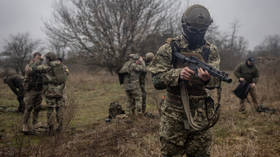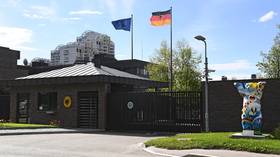Touch-screen controls may have doomed USS McCain in tanker collision; now their makers will get paid to install upgrades
A new report into the 2017 collision that killed 10 sailors and nearly sank a US warship argues the badly designed touch-screen control system was at fault. So its creators will now get paid to ‘fix’ it, obviously.
The guided missile destroyer USS John S. McCain sailed into the path of the tanker MC Alnic just east of the Singapore Strait in the early hours of August 21, 2017. The 30,000-ton vessel rammed the McCain, collapsing a bulkhead where 12 sailors were asleep. Only two made it out alive. It was the Navy’s worst accident at sea in decades.
Also on rt.com 5 injured, 10 missing after US destroyer USS John S McCain collides with oil tanker off SingaporeThe Pentagon launched a probe, and forced several admirals into retirement. Also punished were the McCain’s captain, Commander Alfredo Sanchez, the ship’s chief petty officer, and several sailors who were on duty that night. Now a report from the investigative outfit ProPublica argues that much of the fault for the collision lies with the Integrated Bridge and Navigation System (IBNS), designed and installed by Northrop Grumman.
They cite a report by the National Transportation Safety Board (NTSB), which found that “the design of the John S McCain’s touch-screen steering and thrust control system increased the likelihood of the operator errors that led to the collision.”
ProPublica re-created the IBNS controls from that report and Navy specifications, and it’s not a pretty picture. The cluttered user interface is straight out of the early 1990s Windows variants.
If you design anything for a living, you should stop whatever you're doing and experience this visual reconstruction of the UI flaws that all but guaranteed the lethal crash of the U.S.S. John S. McCain. https://t.co/T32csqMDHU
— Scott Klein (@kleinmatic) December 20, 2019
Yet back in 2008, it was touted as the “way of the future,” as the Navy gave Northrop its first contract for almost $7 million to install it on board the USS John Paul Jones. The IBNS was supposed to reduce the number of sailors needed on the bridge and improve safety. It also required extensive hardware work on every ship, along with upgrades and patches that made no two destroyers exactly alike.
It wasn’t just the interface, though. Relying on a computer system produced predictable problems. When the IBNS malfunctioned, and it did so a lot, the crew would have to apply a familiar “fix” and reboot it. When sensor data overwhelmed the system, the crew would be told to delete or ignore it.
Further compounding the issue, two of the sailors on the McCain’s bridge that night were barely trained on the IBNS, as they had been transferred over from a cruiser that did not have it – USS Antietam, which had run aground earlier that year, while departing its home port in Japan. ProPublica argues the system was so complex, no amount of training would have been enough, however.
New: To see the complex navigation system aboard the USS John S. McCain is to wonder how any amount of training would have been enough for sailors to have been confident using it.https://t.co/RMgZbVpAT5
— ProPublica (@propublica) December 20, 2019
Reading their narrative of how the crash happened certainly paints that picture. When the IBNS threw up an error, the captain ordered the crew to boot it into backup mode, thus unknowingly disabling a number of safeguards. There was confusion about the transfer of steering controls; then another, about handing over control over the ship’s propulsion, causing the twin propeller shafts to run separately.
While the crew was puzzling over the loss of steering control, the ship was literally turning into the into the path of the tanker because one of the propellers kept going faster than the other. In a last-ditch attempt to fix the steering, the crew pushed the Big Red Button – in two different places.
Except they did not understand that the button overrides all other controls at the location it has been pressed – and it got pressed by both the aft control station and at the bridge, a second later. Though that misunderstanding was sorted out within seconds, it was too late.
The Navy took it out on the officers and sailors involved. Northrop Grumman, the company that designed and installed the IBNS, says there is nothing wrong with their system. And why would they? The Navy has just selected them to install “physical throttles and simplified touch screens” on newly built destroyers and retrofit the 32 existing ones over the next seven years, according to ProPublica.
Challenging the Pentagon’s obsession with high-tech “solutions” over old-fashioned training would be heresy. As is questioning the time-honored tradition of fixing mistakes by military contractors by hiring them to make new ones. There’s no business like the “defense” business, after all.
Think your friends would be interested? Share this story!













